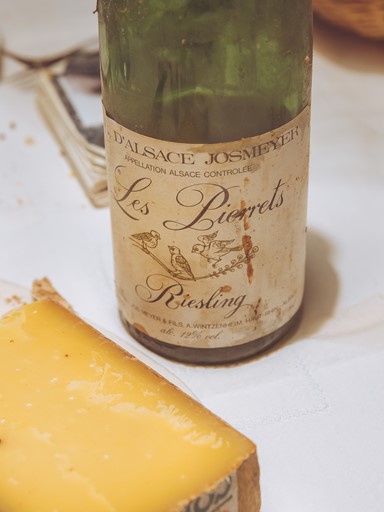
Enter The World Of...
Domaine Josmeyer, Alsace, France
The Torchbearers of Alsatian Culture
Allow us to transport you to the world of Domaine Josmeyer, tucked away in the Alsatian town of Wintzenheim, cushioned between the rolling vineyards of the Grands Crus sites of Hengst and Brand. Enter through the quintessential courtyard, home to a mixture of electric blue and cream half-timbered houses, dotted with colourful sculptures surrounding Céline Josmeyer’s beloved Tilleul tree. To spend a day in this world is the greatest privilege. Home to a winemaking family for over five generations, today cared for and run by two sisters Céline and Isabelle - since 2009 - after the passing of their much-loved father Jean in 2016. We learn about their story and the new wines that these talented women are making.
We've just received a selection of New Arrivals from the estate, so click below to browse our bottles!
View WinesArtistry
The notion of being "un passeur de culture" - a torchbearer of culture, is at the core of the Josmeyer philosophy. From the artistic labels to the considered food and wine pairings, the books, poetry, and wines they immerse themselves in; is all part of the Josmeyer world. Jean used to say that the idea behind his labels was not just to give something beautiful to the wine drinker but to give a projection of what's inside the bottle "like an entrance to an open door". He also started a colour code to depict each cuvée, and it is still used by commissioned artists today. Mise de Printemps will always be yellow and green for spring. Blue for Riesling because it’s the colour of the soul, and "indeed, Riesling always holds a very special place in the heart of an Alsatian", says Céline. Brown for Pinot Gris because of its relationship with the soil and red and pink for Gewürztraminer because of its aromatic, sensual and passionate profile.
The 2020 vintage marks the new artist series, and Isabelle explains that she loves how Alma Bucciali's work seeks this contrast between the real and the imaginary. As seen on the Mise du Printemps 2020 label. The soothing serenity of the Unicorn, surrounded by lush green plants, evokes the importance of the indoor garden in these confined and difficult times. As a winemaker, Isabelle explains the link between what she visualises and how the wine tastes. "When I design a label, I draw what I see in the barrels. The Mise du Printemps is the first wine that we bottle each year, and so it is filled with all of the hope of a new vintage and a toast to the brighter days to come."
Céline is responsible for the beautiful accompanying poetry on the back labels and the refreshing vintage reports - unlike any others you might have seen! But most importantly, she takes care of the vineyards, she makes all of the biodynamics preparations, and she manages the Domaine!
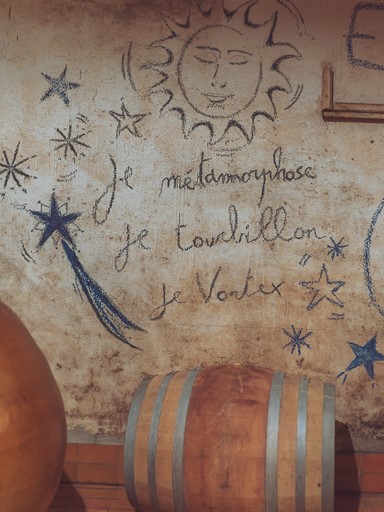
“Keep intact the rustle of the earth, the colour of time, the sparkle of the grape, the energy of the living, this part of the unknown, the precision and the momentum, the emotion of a wine, like a poem in the wind.”
Céline Meyer.
Style
Jean was known to have had a discerning palate. As a member of the Académie International des Vins - he would meet with winemakers from around the world, twice a year, to compare and contrast and learn what it takes to make great wines. Gaston Huet was arguably his greatest influence and responsible for encouraging Jean to convert to biodynamics.
“Everything comes from what dad put in. The relationship with art was his influence, so too the unusual names - it was all him. My father defined the Josmeyer style,” says Céline. “Our house style is first and foremost - always dry. Like with the Pinot Gris - he was one of the first to make a dry Gewürztraminer in Alsace. He used to host dinners with journalists and would only serve Gewürztraminer to show them that you could enjoy it for apéritif, the main course, cheese and the desert!
Another crucial element is balance. To achieve a 12-12.5% abv is important together with a precise structure, purity, elegance, good acidity and length. But also, to make wines with character that don’t taste like others."
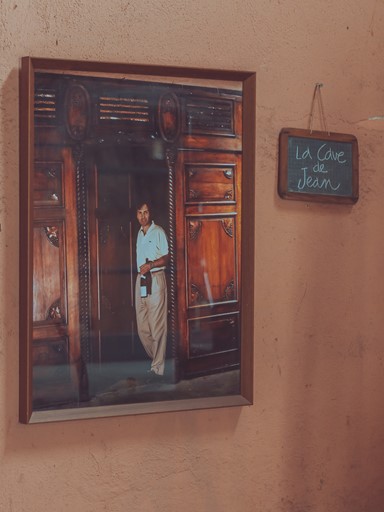
"We reject conformity - there’s a defining difference in everything we do, from the labels to names of the wines - Dad wanted to create his own identity so that we stood out."
Liberté
Today Céline and Isabelle are opening up to new opportunities outside the confines of the appellation, whilst respecting the founding elements that define Josmeyer as the cult wine that Jean intended it to be. Although Céline tells me that her father would never have made wines outside of the appellation.
With this comes a brand-new release of Libre Sous le Ciel (free under the sky), a beautifully made, skin contact Gewürztraminer. 2020 also marks the third vintage of the delicious Chante Pinot, a NV Pétillant Naturel.
“We’ve never made a crémant - it was a deliberate move for dad", says Céline. "We don’t do crémant because Champagne is better; we don’t do Pinot Noir because Burgundy do it better" (a gentle nod to what Jean used to say) "but as the weather has changed, we can now make very good Pinot Noirs in Alsace” explains Céline.
Icare is another creation born from this newfound freedom. A beautifully characterful wine made from a parcel in the famous Grand Cru Hengst site.
“We wanted to make this wine outside the appellation as we were keen to move away from the regular style found here in Alsace. We go above the appellation, pushing the boundaries of our creativity - to make a wine without constraints. We bottled it in a different shaped bottle and haven’t included the grape variety on the label. This way, people can discover new things that wouldn’t have been possible had they known the grape variety. We didn’t want it to be compared to a Pinot Gris from Alsace - instead, we wanted it to be compared to the best quality dry white wines from France.”
Céline explains that most of these opportunities present themselves in the form of an instinctive feeling rather than a deliberate plan. But there is one very exciting plan that does require considerable forethought, and that is to plant Pinot Noir on the Grand Cru Hengst site - which, if all goes to plan, will add a Grand Cru Pinot Noir to the portfolio.
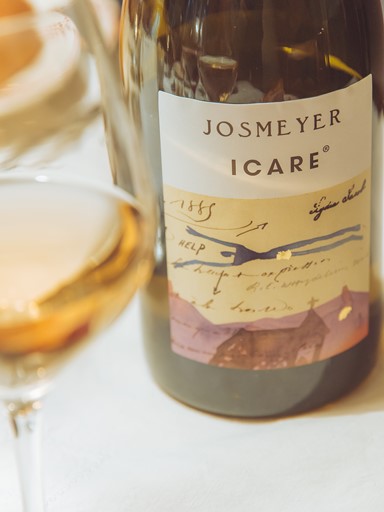
“True freedom is to do things our way"
Alchemy
“Dad was meticulous about food and wine pairings. We didn’t know if he made food for wine or wine for food” explains Isabelle as we sat down for lunch in Céline’s apartment - overlooking the courtyard - adorned with the most tasteful antiques and beautifully curated artworks, we soon realise that the apple doesn’t fall far from the tree. Isabelle pours the first glass of Mise du Printemps - which is quickly followed by a “wow” from both the photographer - Tom, and me; with a very modest “thank you”, Isabelle explains how her father was the ultimate perfectionist - taking his food and wine pairings to a serious level. “He loved wine so much - he would write all about it - there are pages and pages of notes on Alsatian cheese and wine pairings. It was serious business. It wasn’t a game. He was very precise.” We knew that we were in for an incredible Alsatian meal and that each element had been considered with great precision.
“Boeuf gros sel - a typical Alsatian dish was one of Jean's favourites to pair with older vintages. Proving that that salinity of the dish (gros sel) and old vintages of Riesling’s go really well together.”
This conversation sparked an idea… which lead Céline to suggest that we try an old Resiling with the aged Comté that she had bought especially for us even though she doesn’t eat cheese. The next thing we know, Isabelle is in the cellar searching for the perfect bottle. She comes back with a bottle of 1983 Riesling Les Pierrets.
“Dad really liked this vintage - despite the journalist not liking it very much. 1983 wasn’t considered a good vintage, but each time he had the opportunity to show it, he would because he wanted to show them that it was very good.”
The bottle was opened with bated breath… but Isabelle’s smile confirmed that we were in for a treat - this bottle has almost 40 years of stories to tell!
Isabelle explained that the delegation of Comté cheese would send students to Alsace, and Jean would host them. “They always thought that Pinot Gris and Comté was the best match, but actually, dad showed them that Riesling was the one!”
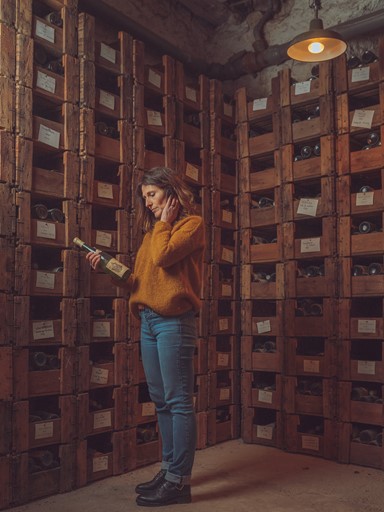
Isabelle begins to taste the Riesling and the Comté together…
“Honestly, there’s something incredible going on here, like a salty creaminess that comes out with the old Comté - they both melt away perfectly - like a unity where one becomes the other. This is super interesting... Do you see? Now we’re in the language of salt as dad would say - it’s exactly this that dad would search for - the fine balance between the ultimate food and wine pairing. We’ve never tasted a 1983 with Comté before. This really moves me.”
Of course, this takes both sisters back to a time with their father. Céline explains that when the perfect match is found - it goes beyond wine.
“This moment that we just had; this is the helm. It’s why we do what we do. Everything that we’ve worked towards in the year comes together in a moment like this - and it’s this that motivates us. As I said before, we work instinctively, and that was a little bit of magic that just happened.
